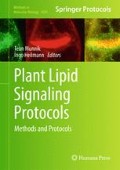Abstract
Phospholipase D (PLD) hydrolyzes structural phospholipids like phosphatidylcholine (PC) and phosphatidylethanolamine (PE) into phosphatidic acid (PA) and free choline/ethanolamine. In plants, this activity can be stimulated by a wide variety of biotic and abiotic stresses (Li et al., Biochim Biophys Acta 1791:927–935, 2009; Testerink and Munnik, J Exp Bot 62(7):2349–2361, 2011). This chapter describes a protocol for the measurement of PLD activity in vivo. The protocol takes advantage of a unique property of PLD, i.e., its ability to substitute a primary alcohol, such as 1-butanol, for water in the hydrolytic reaction. This transphosphatidylation reaction results in the formation of phosphatidylbutanol (PBut), which is a specific and unique reporter for PLD activity. The assay is highly sensitive for detecting PLD activity in vivo, following stimulation of intact plant cells, seedlings, and tissues, being a valuable method for studying the regulation of plant PLD activity in vivo.
Access this chapter
Tax calculation will be finalised at checkout
Purchases are for personal use only
References
Li M, Hong Y, Wang X (2009) Phospholipase D- and phosphatidic acid-mediated signaling in plants. Biochim Biophys Acta 1791:927–935
Testerink C, Munnik T (2011) Molecular, cellular, and physiological responses to phosphatidic acid formation in plants. J Exp Bot 62:2349–2361
Pappan KL, Wang X (2012) Assaying different types of plant phospholipase D activities in vitro. Meth Mol Biol. 1009:205–217
Arisz SA, Testerink C, Munnik T (2009) Plant PA signaling via diacylglycerol kinase. Biochim Biophys Acta 1791:869–875
Heller M (1978) Phospholipase D. Adv Lipid Res 16:267–326
Quarles RH, Dawson RM (1969) The distribution of phospholipase D in developing and mature plants. Biochem J 112:787–794
Walker SJ, Brown HA (2004) Measurement of G protein-coupled receptor-stimulated phospholipase D activity in intact cells. Methods Mol Biol 237:89–97
Munnik T, Arisz SA, De Vrije T, Musgrave A (1995) G protein activation stimulates phospholipase D signaling in plants. Plant Cell 7:2197–2210
Frank W, Munnik T, Kerkmann K, Salamini F, Bartels D (2000) Water deficit triggers phospholipase D activity in the resurrection plant Craterostigma plantagineum. Plant Cell 12:111–124
den Hartog M, Musgrave A, Munnik T (2001) Nod factor-induced phosphatidic acid and diacylglycerol pyrophosphate formation: a role for phospholipase C and D in root hair deformation. Plant J 25:55–65
Bargmann BO, Laxalt AM, ter Riet B, Testerink C, Merquiol E, Mosblech A, Leon-Reyes A, Pieterse CM, Haring MA, Heilmann I, Bartels D, Munnik T (2009) Reassessing the role of phospholipase D in the Arabidopsis wounding response. Plant Cell Environ 32:837–850
Bargmann BO, Laxalt AM, ter Riet B, van Schooten B, Merquiol E, Testerink C, Haring MA, Bartels D, Munnik T (2009) Multiple PLDs required for high salinity and water deficit tolerance in plants. Plant Cell Physiol 50:78–89
Darwish E, Testerink C, Khaleil M, El-Shihy O, Munnik T (2009) Phospholipid-signaling responses in salt stressed rice leaves. Plant Cell Physiol 50:986–987
Van der Luit AH, Piatti T, van Doorn A, Musgrave A, Felix G, Boller T, Munnik T (2000) Elicitation of suspension-cultured tomato cells triggers the formation of phosphatidic acid and diacylglycerol pyrophosphate. Plant Physiol 123:1507–1516
Munnik T, de Vrije T, Irvine RF, Musgrave A (1996) Identification of diacylglycerol pyrophosphate as a novel metabolic product of phosphatidic acid during G-protein activation in plants. J Biol Chem 271:15708–15715
Ramos-Diaz A, Brito-Argaez L, Munnik T, Hernandez-Sotomayor SM (2007) Aluminum inhibits phosphatidic acid formation by blocking the phospholipase C pathway. Planta 225:393–401
Munnik T, Meijer HJ, Ter Riet B, Hirt H, Frank W, Bartels D, Musgrave A (2000) Hyperosmotic stress stimulates phospholipase D activity and elevates the levels of phosphatidic acid and diacylglycerol pyrophosphate. Plant J 22:147–154
den Hartog M, Verhoef N, Munnik T (2003) Nod factor and elicitors activate different phospholipid signaling pathways in suspension-cultured alfalfa cells. Plant Physiol 132:311–317
Meijer HJ, ter Riet B, van Himbergen JA, Musgrave A, Munnik T (2002) KCl activates phospholipase D at two different concentration ranges: distinguishing between hyperosmotic stress and membrane depolarization. Plant J 31:51–59
Zonia L, Munnik T (2004) Osmotically induced cell swelling versus cell shrinking elicits specific changes in phospholipid signals in tobacco pollen tubes. Plant Physiol 134:813–823
Lanteri ML, Lamattina L, Laxalt AM (2011) Mechanisms of xylanase-induced nitric oxide and phosphatidic acid production in tomato cells. Planta 234:845–855
De Vrije T, Munnik T (1997) Activation of phospholipase D by calmodulin antagonists and mastoparan in carnation petal tissue. J Exp Bot 48:1631–1637
Distefano AM, Garcia-Mata C, Lamattina L, Laxalt AM (2008) Nitric oxide-induced phosphatidic acid accumulation: a role for phospholipases C and D in stomatal closure. Plant Cell Environ 31:187–194
Munnik T, Zarza X (2013) Rapid analysis of plant signaling phospholipids through 32Pi-labeling and TLC. Meth Mol Biol. 1009:3–15
Munnik T (2001) Phosphatidic acid: an emerging plant lipid second messenger. Trends Plant Sci 6:227–233
Acknowledgments
This work was supported by grants from the Netherlands Organization for Scientific Research (NWO; VIDI 864.05.001), the EU (COST FA0605), the Universidad Nacional de Mar del Plata (UNMdP), Consejo Nacional de Investigaciones Científicas y Técnicas (CONICET), and Agencia Nacional de Promoción Científica y Tecnológica (ANPCyT). We thank Jiorgos Kourelis for performing the experiment described in Fig. 1.
Author information
Authors and Affiliations
Editor information
Editors and Affiliations
Rights and permissions
Copyright information
© 2013 Springer Science+Business Media, LLC
About this protocol
Cite this protocol
Munnik, T., Laxalt, A.M. (2013). Measuring PLD Activity In Vivo. In: Munnik, T., Heilmann, I. (eds) Plant Lipid Signaling Protocols. Methods in Molecular Biology, vol 1009. Humana, Totowa, NJ. https://doi.org/10.1007/978-1-62703-401-2_20
Download citation
DOI: https://doi.org/10.1007/978-1-62703-401-2_20
Published:
Publisher Name: Humana, Totowa, NJ
Print ISBN: 978-1-62703-400-5
Online ISBN: 978-1-62703-401-2
eBook Packages: Springer Protocols

